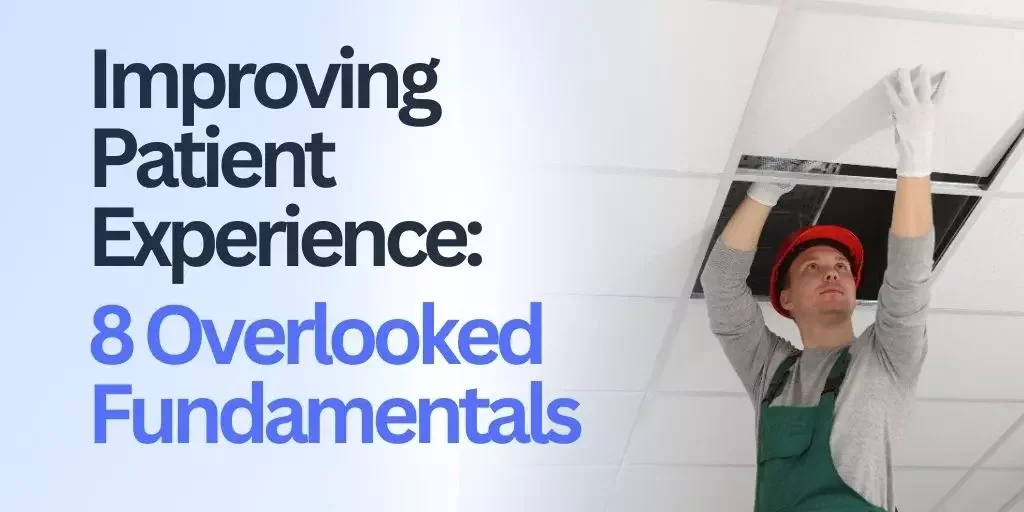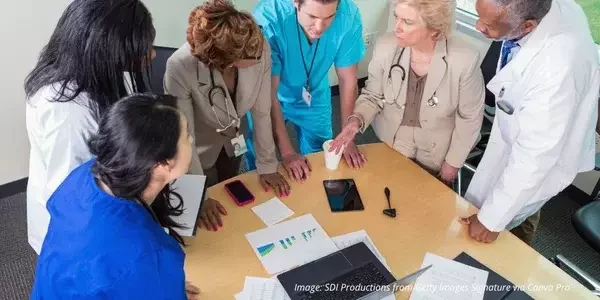
Patient experience is a complex area, with some aspects going unnoticed and others not fully understood. Based on our extensive experience working with various hospitals, we wanted to share the important but often overlooked factors that have a big impact on both patient satisfaction and higher satisfaction scores.
Achieving high patient satisfaction and a positive patient experience in healthcare involves several fundamental principles, including:
- There is no one-size-fits-all solution
- The importance of real-time issue identification & correction
- The involvement of all departments in the process
- The necessity of a robust service recovery system
- The understanding that HCAHPS is just a scoreboard
- The need for excellence in all operations
- The focus on patient care within the continuum of care
- The continuous process of learning & improvement
Summary: Action Items Checklist
Key Takeaway: What you can do today to improve your patient’s experience
Without further ado,
The 8 Overlooked Fundamentals of Patient Experience:
1. There Is No One-Size-Fits-All Solution
When it comes to patient experience, keep this in mind: there's no magic formula that fits all. Many hospitals fall into the trap of thinking that concentrating solely on one aspect, be it rounding or food quality, will work wonders. However, it's crucial to see the bigger picture.
While you can't skyrocket one element by 1000%, you can gradually improve 1,000 things by 1%--the popular sentiment from Jan Carlzon.
To truly succeed, you need a comprehensive approach that takes into account various aspects of your organization. Don't put all your eggs in one basket—spread your efforts and focus on the broader vision for sustainable success in patient satisfaction and experience.
Action Step:
Compile a list of all aspects or departments that affect patient satisfaction and then determine whether you have the resources to help you manage and improve all aspects efficiently.

2. The Importance of Real-Time Issue Identification & Correction
When it comes to patient satisfaction and experience, real-time issue identification and correction are the name of the game. It's not about gathering heaps of data to analyze later; there's already enough of that going around.
The real value lies in spotting problems as they happen and taking immediate action.
For instance: it's great to know historically that patients have trouble understanding their medication, but it's even better to identify and fix the issue while they're still in your care.
This proactive approach can make a real difference in reducing readmissions.
In healthcare, speed matters. If the banking industry processed data as slowly as we do in healthcare, an ATM transaction would take a day. So, shift the focus from data analysis to tackling issues head-on in real time.
Action Step:
Begin viewing improvements as an act that happens in the moment, not after the fact. The easiest way to execute improvements as they happen is with an electronic system that creates and tracks issues in real-time. Don't ignore process improvement efforts but stay heavily focussed on sustainable real-time feedback.
3. The Involvement of All Departments in the Process
Patient satisfaction isn't a responsibility that falls solely on the shoulders of the nursing staff. It's a team effort that involves every department within a hospital. While nursing certainly plays a critical role, so do hospitalists, accountants, engineers, executives, etc.
To truly excel in patient satisfaction and experience, it's essential to ensure that every department is consistently and proactively engaged in these efforts.
The benefits are numerous:
- Nursing doesn't bear the entire accountability burden
- Resources are available for daily customer service interactions with patients
- Managers from non-clinical departments gain a deeper understanding of frontline customer service realities
It truly fosters a sense of teamwork, where everyone contributes to the shared goal of enhancing the patient experience.
Action Step:
Each department must know how they contribute to patient satisfaction and experience. If you need examples, refer to this blog post, The 10 Things I Wish I Received as a Patient, to get a better understanding of what the patient is really thinking and how their experience is much more than just their nursing care team.

4. The Necessity of a Robust Service Recovery System
Service failures happen, and they often lead to patient dissatisfaction. It's crucial to have a robust service recovery system in place to address these issues promptly.
Whether it's patient unhappiness with food, complaints about outdated communication boards, or treatment delays, problems will arise. However, the key is not just in preventing errors but in how you respond when they occur.
Instead of saying, "It's not my job," the immediate response should be, “I am so sorry,” and, "I will get that taken care of now."
Don't underestimate the power of a sincere apology followed by swift action. Most people respond positively when a mistake is acknowledged and rectified promptly. It's not about avoiding service failures altogether; they will happen. The real question is whether you can identify them and respond effectively in a timely manner.
Action Step:
Evaluate if you have a service recovery process that: 1) is electronically-based, 2) automatically sends a service recovery item to be fixed to the appropriate department, and 3) automatically sends follow-up reminders until the issue has been resolved. If your process doesn’t encompass all three aspects, it is time to upgrade to a digital solution with automatic service recovery built-in.
5. The Understanding that HCAHPS Scores is just a Scoreboard
While HCAHPS scores are important, it's crucial to recognize that they are just a scoreboard for patient satisfaction and experience.
Many hospitals obsessively monitor these scores due to their financial and reputational implications. However, focusing solely on the scoreboard can be misleading. It's akin to playing a game of tennis–while watching the scoreboard–you will know the score but you will lose the game.
The key is to concentrate on playing the game well, improving every aspect of patient care and experience and then occasionally glancing at the scoreboard.
Action Step:
Determine whether your facility uses HCAHPS scores as the sole metric in patient satisfaction. If so, consider adding other metrics, so as to create a more well-rounded patient experience, such as: your hospital environment, executive leadership rounding, patient communication boards, proactive roundly rounding, and more. Remember, in order to measure these types of metrics, data must be collected on an on-going basis–a digital rounding software that encompasses all aspects of patient experience will be the quickest and easiest way to gather that data.
6. The Need for Excellence in All Operations
Expanding on #1: Excellence in all operations is a fundamental principle often overlooked in the pursuit of patient satisfaction and experience.
It's not just about providing great medical care; every aspect of a hospital's daily operations matters. From ensuring billing is understandable to keeping bathrooms spotless, from maintaining clean ceiling tiles to offering user-friendly educational materials, each detail impacts the overall patient experience. Even outpatient wait times and food quality play a crucial role.
Hospitals should actively gather and review patient feedback daily, ensuring that navigating the facility is intuitive and that every operational aspect is optimized. In essence, excellence should permeate every nook and cranny of a healthcare organization to truly elevate patient satisfaction and experience to the highest level.
Action Step:
The key here is tracking two things: 1) not just gathering patient feedback on their care only, but to incorporate feedback on all aspects of their stay (maintenance, food, environment, etc.), and 2) not just measuring patient satisfaction based on nursing performance, but to track and gather data on the performance of all departments of the hospital that contribute to patient satisfaction.
7. Patient Care while in Continuum of Care
Patient satisfaction or experience isn't just about collecting historical data on satisfaction; it's about a proactive approach within the continuum of care.
Rather than asking patients, "How did we do?" after the fact, it's far more impactful to inquire, "How are you doing?"
This means meeting with inpatients daily, and involving all managers, not just nursing, in gathering feedback. For outpatients, collecting feedback as they leave and addressing issues before they depart is crucial. Post-discharge calls to both inpatients and outpatients, conducted within days of their departure, provide an opportunity to address any lingering concerns.
Additionally, connecting senior management with frontline staff through executive rounding ensures that resources and support are readily available for delivering high-quality care. It's not just about gathering data; it's about actively engaging with patients throughout their healthcare journey to ensure their well-being and satisfaction are consistently met.
Action Step:
Determine whether or not you have a streamlined process for checking on patients during and directly after the care. The process must have a built-in service recovery element to process any issues in real-time in order to address the patient’s concerns while they are still in the continuum of care.

8. The Continuous Process of Learning & Improvement
The journey towards 5-star patient satisfaction and experience is an ongoing process of learning and improvement. Real-time responses to service failures not only enhance immediate patient experience but also fuel a cycle of constant refinement.
Analyzing and rectifying systematic issues unearthed through feedback leads to continuous enhancements. It's crucial to embrace a culture of perpetual learning and adaptation in a real-time environment. As John Wooden wisely said, "It's what you learn after you think you know it all that really matters." This ethos underscores the importance of staying vigilant, responsive, and adaptable in the pursuit of providing the best possible care and experience to patients.
Action Step:
Evaluate whether your hospital celebrates failures in the sense that it is an opportunity for further improvement. A willingness to look at the data, good or bad, is a good sign that your culture embraces continued learning and improving. Again, data is key here, because without it, you cannot see what needs improving–and that data is only as good as the analysis it provides. A system that is tied to your data, that can automatically provide understandable reports is the best way to track meaningful, on-going improvements.
